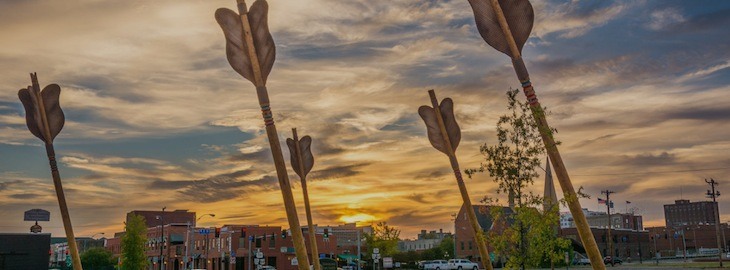Report shows arts and culture activity expanding nationwide; Arkansas industry small, but growing
by April 25, 2017 1:39 pm 968 views

A large art installment was part of the 2016 Unexpected event in downtown Fort Smith. Propak CEO Steve Clark founded and helped fund the project.
Arts and cultural economic activity accounted for 4.2% of the U.S. gross domestic product, or $730 billion, in 2014, according to a report released April 19 by the Bureau of Economic Analysis.
The BEA measured total spending on all arts and cultural goods and services to be $1 trillion in 2014. The bureau’s report, funded in part by the National Endowment for the Arts, looks at creative artistic activity, the goods and services produced by it, and the construction of buildings in which it is taking place. It covers performing arts companies and promoters, museums, architectural services, media, advertising and government.
Arts and cultural activity rose in 24 states, including Arkansas, between 2013 and 2014, showing an average nationwide growth rate of 2%. The arts and culture industries’ estimated sales increased 2.4% during the same time period. Numbers are adjusted for inflation, according to the bureau.
Patrick Ralston, director of the Arkansas Arts Council, said the information put out by the BEA “is encouraging.”
“We’re seeing positive growth, even 10 years after the beginning of the Great Recession,” Ralston said, pointing to advances during the last decade in various areas of the state. “Without a doubt, when you’re looking down at Arkansas from space, you see a tremendous expansion of arts and cultural opportunities in Northwest Arkansas.”
Ralston said NWA has thrived because of an “understanding that creating a corporate culture is hollow without the cultural and artistic component. It’s a valuable lesson that can be imparted to other parts of the state. As your economy booms, you must pay attention not just to the financial end but also to the subtleties of the creative economy, creative culture, preserving and expanding your cultural institutions.”
PLACEMAKING STRATEGY
Ralston praised the South Main neighborhood in Little Rock and the North Little Rock community of Argenta for creating cultural hubs, both using long-term planning and the conduit of historic preservation.
Mixed-use development and careful street planning to encourage pedestrian activity have been the methods used in the so-called “SoMa” district, while Argenta reinvigorated an adjacent residential neighborhood alongside progress in traditional business development, Ralston said.

“The two have developed hand-in-hand in a way that is amazing in how successful it’s been. People make art in places that bring them comfort and inspiration, where the physical environment is preserved and is treasured,” he said. “Community development is really the new frontier in what we do.”
He also pointed to industrial diversification in Jonesboro and an increasingly educated populace through Arkansas State University as advantages in “supporting the kind of creative outlets that are part of building this creative economy.”
On the cultural side, ASU’s heritage studies program is a source of enrichment, whether that means helping to restore the boyhood home of Johnny Cash in Dyess or embracing the Delta’s agricultural history
“They are an institution that has committed themselves to this concept of understanding the community they reside in. the culture that they reside in,” Ralston said. “When you have that kind of value, you place value on the components, the history of your community, through the preservation of buildings and culture. It’s an aspect that we find is very necessary in building this community of creators.”
Fort Smith is a good example of a community that has business diversity and is using placemaking efforts downtown, he added.
“There’s a spectrum of community planning and activity where you can say that on one end is the investment in your community and reinvestment and reuse of a community’s resources, its buildings, its spaces. On the other end of the spectrum is letting downtown go and moving everything out to bypass,” Ralston said, adding that Fort Smith is on the former end of the spectrum.
In reference to the city’s public art project, “The Unexpected,” he said: “One of the things that I love about ‘The Unexpected’ is that it comes in and takes over spaces that are familiar. The community has grown up with these buildings and spaces, and ‘The Unexpected’ is bringing energy and art directly into the frame in an area where you might not expect that.”
ARTS & CULTURE JOBS IN ARKANSAS, NATIONWIDE
Arts and cultural employment nationwide grew 1.3% in 2014, the same pace reported for 2013. The total number of arts and culture jobs was 4.8 million, accounting for 3.3% of all jobs in the United States. Employment growth across all states ranged from a low of -5.8% in Montana to a high of 5.7% in Washington, where software design and online retailer jobs boosted the average salary for arts and culture careers to $111,890 in 2014, according to the bureau.
Arkansas saw a 2% bump in employment for arts and culture industries, compared to 1.3% growth nationwide. The Bureau of Economic Analysis tied 34,186 jobs in Arkansas to the category, accounting for 3% of statewide employment and 2.7% ($1.5 billion) of compensation. A figure called a location quotient rates Arkansas’ emphasis on arts and culture as 10% below the national average.
“I‘m disappointed that it wasn’t higher, but that sets the bar for us,” Ralston said. “We can look at our neighboring states like Missouri, Kansas, and places like New Mexico and Illinois and seek to raise the bar a little higher.”
The average salary for arts and culture industries, Arkansas ranked 35th nationwide at $45,123 in both 2013 and 2014, and compensation growth at 3.8% between the two years is slower than the national average of 5%.
“A lot of these things are driven by the actual size of the economy,” Ralston said. “Arkansas is not historically a wealthy state. It’s a state with an aging demographic. Very often, we see a certain lag in economic indicators in this and other sectors.”
In addition to arts and cultural entities, the BEA report includes organizations, including government, that support arts and culture, and that segment showed employment growth of 0.5% in 2014, to a total of 3.6 million jobs. Art support services, including government, and art information services, including publishing, motion pictures and broadcasting, each accounted for 1.2 million jobs in 2014.
NEXT STEPS
With a grant from the NEA, the Arts Council this spring is conducting roundtable discussions throughout the state on building the creative economy.
“There are so many communities here in Arkansas that have figured out the right combination of infrastructure, economic incentives and planning, to develop a culture and a community of artists,” Ralston said. “We want to figure out the best practices for how the communities can do this and package in the way and provide technical service to communities wanting to expand their fine arts, especially into parts of the state that have been traditionally underserved in terms of visual and performing arts, education. It will cover a range of issues, from what technical services they need, to what decision-makers can do on a local level and what the Arts Council can do through grant-making and partnership.
“We know that arts can be an economic engine, the question is, how can we make it a more efficient?” Ralston said.
